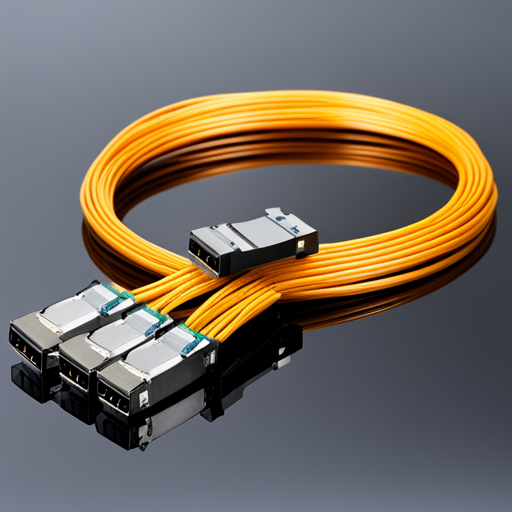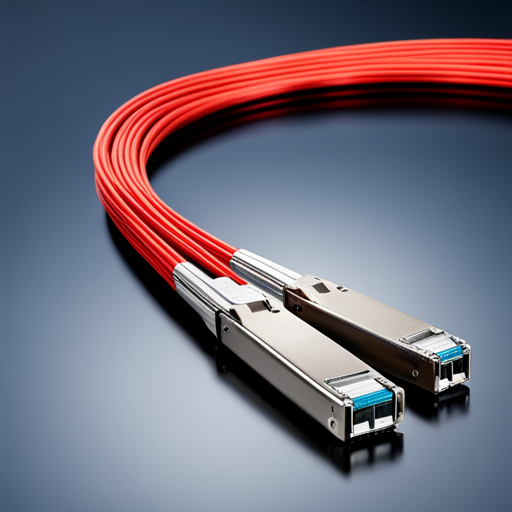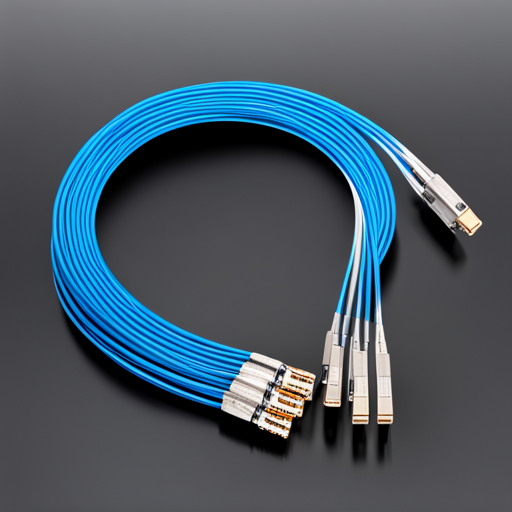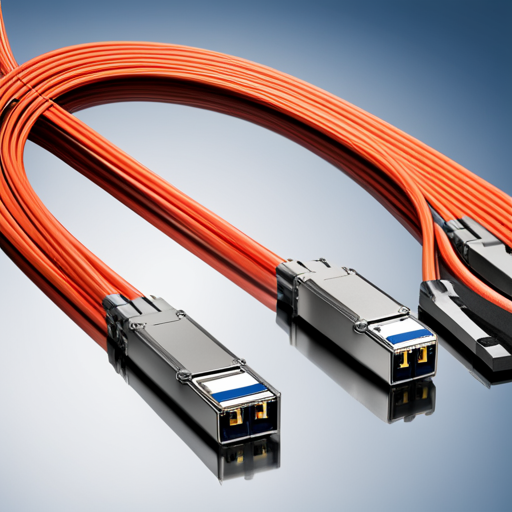
DAC (Direct Attach Cable) and AOC (Active Optical Cable) are standard cable technologies used for data transmission in modern computing systems.
Recommended Products:200G QSFP56 Breakout DAC
DAC cable is a copper-based cable that connects two networking devices with SFP or QSFP connectors. It is designed for short-range data transmission, typically within a data center or rack-level communication. The maximum transmission distance of a DAC cable is generally limited to 7 meters. DAC cables, also known as twin axial cables, can transmit data at high speeds of up to 40 Gbps.
An AOC cable, on the other hand, utilizes fiber optic technology for data transmission. It employs a similar design as a DAC cable but uses fiber optic instead of copper wire. The AOC cable has an optoelectric transceiver on the cable ends that converts the electrical signals into optical signals and then sends them over the fiber. AOC cable typically offers a higher transmission distance of up to 100 meters or more and can transmit at higher speeds of up to 400 Gbps.
The critical difference between DAC and AOC cables lies in their technology and design. DAC utilizes copper wire, offering a shorter transmission distance but a higher speed. In contrast, AOC uses fiber optic and provides a longer but slightly lower rate due to additional conversion steps. DAC cables are more power-efficient, whereas AOC cables are generally more expensive.
Both DAC and AOC cables offer several benefits in modern computing systems. These cables can reduce latency, and higher performance and power efficiency. They are also easy to install; no additional drivers or software are required. DAC cables are generally more cost-effective and offer higher speeds, whereas AOC cables can support longer distances and offer better signal quality over long distances.
Recommended Products:200G QSFP56 Breakout AOC
Both technologies come with certain limitations. One of the most significant drawbacks of DAC cables is their short transmission distance, which limits their usefulness in larger data center environments. AOC cables, on the other hand, are more expensive than their copper-based counterparts. Besides, converting electrical to optical signals in AOCs introduces additional hardware components that might degrade signal quality and impact performance.
In conclusion, DAC and AOC are two essential technologies that offer high-speed data transmission for modern computing systems. While both have different strengths and weaknesses, the choice between them ultimately boils down to an organization's specific use case and requirements. Organizations may opt to use DAC cables for short-range communication work in data center environments. In contrast, AOC cable technology may be more optimal for long-range communication (such as those found between different buildings).

Active Optical Cable (AOC) and Direct Attach Copper Cable (DAC) are cable technologies used in data center networking and computing applications.
AOC is an optical cable embedding optical fibers and microelectronics within a cable jacket. The line uses lasers and photodiodes to convert electrical signals into optical signals, which are transmitted through the fiber cables.
1. AOC supports longer transmission distances than DAC, up to 100 meters for 40Gbps or 10Gbps.
2. AOC is less susceptible to electromagnetic interference (EMI) than DAC, increasing reliability in noisy environments.
3. AOC can be more expensive than DAC, especially for shorter transmission distances.
DAC is a copper cable with an SFP+ or QSFP+ connector. The cable technology eliminates the need for a separate transceiver and delivers electrical signals directly from one device to another.
1. DAC is typically less expensive than AOC for shorter transmission distances.
2. DAC is more durable than AOC, making it more suitable for cable management applications.
3. DAC is more susceptible to EMI, decreasing performance and reliability in noisy environments.
The most significant difference between AOC and DAC is their transmission medium. AOC uses optical fibers, and DAC uses copper wires. AOC is generally used for longer transmission distances, whereas DAC is suitable for shorter distances.
AOC is preferred when high performance, long transmission distances, and low EMI susceptibility are vital factors. It is commonly used in data centers and computing applications, such as high-performance computing (HPC) clusters, switches, and storage interconnects.
DAC is an excellent choice for short-distance transmission, where the cost is a primary consideration. It is widely used in data center applications where copper cables are ideal for connecting devices nearby. Some typical applications include switch-to-server connections and rack-to-rack connections.
Recommended Products:200G QSFP56 AOC

Data transmission is an essential aspect of modern-day technology, not limited to wireless communication. Wired communication through cables is still prevalent, and data center operators use different types of lines for this purpose. DAC (Direct Attached Cable) and AOC (Active Optical Cable) are types of lines widely used in data centers. These cables provide high-speed communication and are popular because they transmit data over long distances without signal degradation.
DAC and AOC cables offer several benefits to data centers. These benefits include high-speed data transmission, low power consumption, improved reliability, and low latency. These cables also provide an affordable and straightforward solution for data center operators as they do not require additional hardware or software for installation. Moreover, DAC and AOC cables offer plug-and-play functionality, which makes them easy to use and install.
While DAC and AOC cables are preferred for data center operators, they have some drawbacks. One major limitation of using these cables is the maximum cable length. DAC cables generally offer a total height of up to seven meters, while AOC cables can transmit data up to 50 meters. Another limitation of DAC and AOC cables is that they are unsuited for high-vibration environments. The delicate fibers in the AOC cables are susceptible to breaking or becoming weak in high-vibration environments.
DAC and AOC cables are only suitable for short-distance transmission. The maximum cable length offered by DAC cables is up to seven meters, while AOC cables can transmit data over a distance of up to 50 meters. These limitations are due to the limited resistance of the wires to signal degradation and interference.
DAC and AOC cables can help data center operators save money in several ways. These cables are less expensive than other types of copper or fiber-optic cables. They are also easy to install and do not require additional hardware or software, saving on installation costs. Moreover, these cables offer low power consumption and are more energy-efficient than other cables, reducing operational costs.
DAC and AOC cables are preferred for short-distance communication within a data center. The best applications for DAC and AOC cables in data centers include high-performance computing, data backup storage, and high-speed interconnects. They are also suitable for applications requiring high-speed communication between devices, such as switches, servers, and storage systems.

DAC and AOC cable connectors are essential for connecting data center equipment, network switches, servers, and storage devices.
A transceiver is a device that transmits and receives signals, typically radio or optical signals. In the context of DAC and AOC cables, a transceiver is a component that converts electrical signals into optical signals for transmission over fiber or lines. The transceiver sends and receives data and is typically contained in SFP, SFP+, QSFP+, or QSFP28 modules that plug into switch ports.
DAC and AOC cables use different connectors depending on the cable type, application, and transmission rate. The most common connector types for DAC cables include SFP and SFP+, which support data rates of up to 10 Gbps, while QSFP and QSFP28 offer higher rates of up to 100 Gbps. The most widely used connectors for AOC cables are SFP, QSFP, and CXP, which support speeds of up to 400 Gbps. Some other popular connectors include LC, MTP/MPO, and CX4.
Using DAC and AOC cables with connectors on both ends offers several advantages. For one, these cables are plug-and-play, meaning they require no additional hardware or adapters. They are also easy to install, reducing installation time and costs. The dual connectors also ensure an active and reliable connection at all times, eliminating the risk of signal loss or degradation.
One disadvantage of using DAC and AOC cables with connectors on both ends is their limited transmission distance, typically no more than 10 meters. Additionally, these cables are not well-suited for use in areas with high electromagnetic interference (EMI) or radio frequency interference (RFI) due to their lack of shielding.
Following best practices when connecting DAC and AOC cables is essential to ensure optimal performance and avoid errors. These include using the correct types of connectors for the line and application, checking compatibility with the equipment and environments, ensuring proper cable routing to avoid sharp bends or kinks, and testing connections before deployment. It is also essential to keep track of cable lengths to avoid exceeding the specified maximum distance limits.

A DAC cable is a copper cable used to transmit digital audio signals. On the other hand, an AOC cable is an optical fiber cable that transmits electrical signals using light. Both can connect electronic devices, but the difference comes in cost, electrical signal transmission, power consumption, and data rate.
Regarding cost-effectiveness, AOC cables can be more expensive than DAC cables. This is because AOC cables use fiber optic technology, which requires costly components and a more complex manufacturing process. However, it is essential to consider the intended use of the cable and the distance it needs to cover. AOC cables are more cost-effective for transmitting signals over longer distances, whereas DAC cables are more affordable for shorter distances.
AOC cables are better for transmitting electrical signals than DAC cables. This is because AOC cables use light to transmit signals immune to electromagnetic interference. DAC cables, however, are copper-based and more susceptible to interference from other electrical devices. AOC cables are also better at maintaining signal integrity over longer distances, making them suitable for applications in sensitive environments like data centers and hospitals.
AOC cables are better for lower power consumption than DAC cables. AOC cables use less power to transmit signals over longer distances than DAC cables, which can consume more power as they lose signal strength over distance. Additionally, AOC cables do not produce heat or require additional cooling measures for longer runs.
AOC cables have a higher data rate than DAC cables. AOC cables use optical fiber technology, transmitting data at higher speeds and greater distances than copper-based DAC cables. The data rate of an AOC cable can reach up to 100Gbps, while DAC cables have a maximum data rate of up to 40Gbps.
In conclusion, DAC and AOC cables have strengths and weaknesses, and each is better for different applications. AOC cables are better for longer distances, higher speeds, and lower power consumption, making them suitable for network transmission over extended distances and in challenging environments. DAC cables are more cost-effective and ideal for shorter distances and consumer electronics. Therefore, it is essential to consider the specific requirements of a project to determine which cable is best suited for that application.

A: DAC (Direct Attach Cable) is a copper cable connecting two network devices directly. AOC (Active Optical Cable) is a fiber optic cable that uses optical technology to transmit data.
A: DAC cables have low latency, are less susceptible to electromagnetic interference, and are cheaper than fiber optic cables.
A: Yes, DAC and direct attach cables are the same. They are copper cables that connect two network devices directly.
A: Passive DAC cables do not require any power source, while active DAC cables require power to transmit data over longer distances.
A: QSFP (Quad Small Form-factor Pluggable) is a transceiver module for high-speed data communication. It is commonly used in servers and storage devices to connect switches and network cards.
A: QSFP can be used with DAC cables, AOC cables, and fiber optic cables.
A: 10G QSFP can transmit data at a rate of 10 Gbps, while 100G QSFP can transmit data at 100 Gbps.
A: The maximum distance a DAC cable can cover is 5 meters.
A: AOC (Active Optical Cable) cables use optical technology to transmit data, while DAC (Direct Attach Cable) cables use copper cabling. AOC vs. DAC refers to comparing these two types of cabling solutions.
A: AOC is an active optical cable that transmits data using optical technology, while multimode fiber is a type of optical fiber that uses multiple light rays to transmit data.